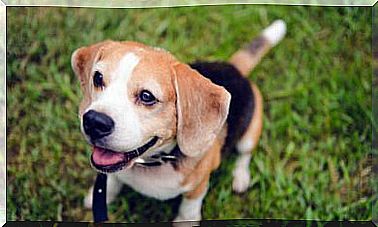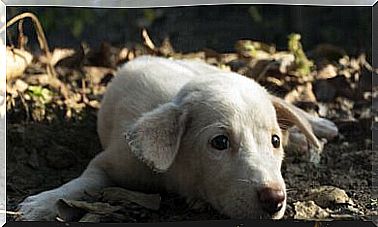Resting Postures: How Does Your Dog Sleep?
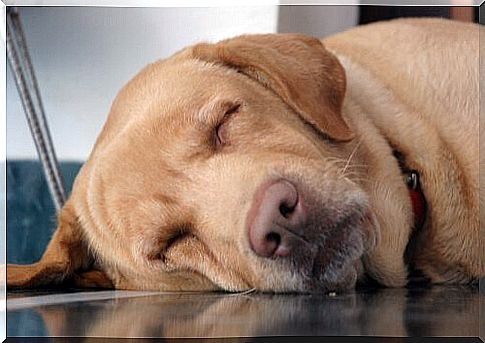
Our little furry friends communicate with us continuously, through their attitude, their posture and the expressions on their faces. They use the body to express their thoughts, emotions and moods. The preferred position to rest says a lot about their feelings: try to pay attention to how your four-legged friend sleeps and you can find out more about his personality.
Tell me how your dog sleeps, and I’ll tell you who he is
You have probably heard of how the way people sleep can say a lot about their emotional state and their health. The same goes for dogs.

Does your dog sleep in a crouch?
Surely you have seen your dog sleeping all curled up, especially on colder days. Her little body folds towards the center forming a sort of very very tender “hair ball”. The head rests on the legs, perfectly joined and superimposed.

This is one of the most common sleeping positions, as it allows dogs to conserve heat and disperse less energy to the outside environment. What do they want to tell us when they hire you? Who feel safe and secure in the place they are, and who can express themselves freely.
Position of the “super dog”
In this position, the front and back legs are fully extended and the belly is resting on the floor or carpet. The head is usually positioned between the two front legs.
If your dog sleeps in this position like a true super hero, it means that he is very happy and that a great energy vibrates in him. So don’t be surprised if your dog assumes this position after you have returned from a nice walk together.
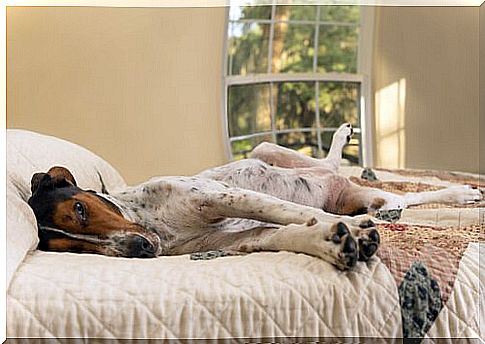
Sleeping on the side: what does it mean?
This is a very common sleeping position among dogs, as they find it very comfortable for sleeping. Dogs adopt it when they feel calm and relaxed in their environment.
The classic and fun “passed out” position
In this position, the dog rests on his back and rests his head on the ground. The front legs are placed over the belly, while the rear ones are stretched upwards. In this way, the dog is able to cool (or ventilate) his body very quickly, as well as being able to get up immediately as soon as he feels an unrecognized stimulus.
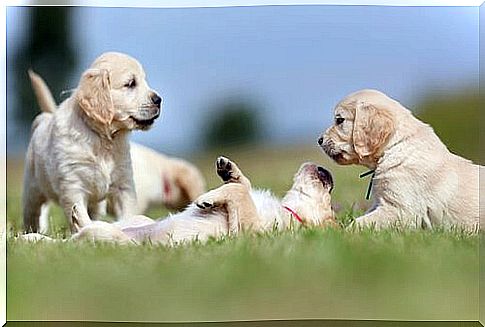
Does your dog sleep on his stomach?
This posture is usually temporary, meaning the dog adopts it before reaching deep sleep. Its belly touches the floor, its hind legs are completely apart, and one or both of its front legs are parallel to the body.
This can also be a common stance in more shy dogs or those who have just arrived in a new home.
“Let’s hope it rains” or “Crazy paws”
This is the most fun resting position to observe in our dog friends. The back is in contact with the floor, the hind legs are open and the front ones are resting on top of the chest. At one time, it was said that dogs who took this position were praying for rain to come.
How many hours of sleep does a dog need?
There are many owners who worry about the number of hours their dog should sleep, especially when he is a puppy. We are so used to our metabolism that it seems strange to us that our animals sleep so much. In fact, however, dogs require more hours of sleep per day than we humans do.
The amount of hours an adult dog needs varies according to age, size and health status. In general, smaller breeds need less sleep than larger breeds. While small dogs tend to sleep between 14 and 16 hours, older dogs can get up to 18 hours of sleep.
A young animal, just entering adulthood, will have much more energy than an elderly one, for example. The same logic applies to healthy dogs, which enjoy a more active metabolism and greater physical endurance. In fact, excessive tiredness and sleepiness can be symptoms of various diseases.
Finally, your dog’s routine also plays a central role in determining how many hours of sleep he needs. A sedentary dog will be able to sleep more hours a day simply because he lives in a less stimulating environment.




